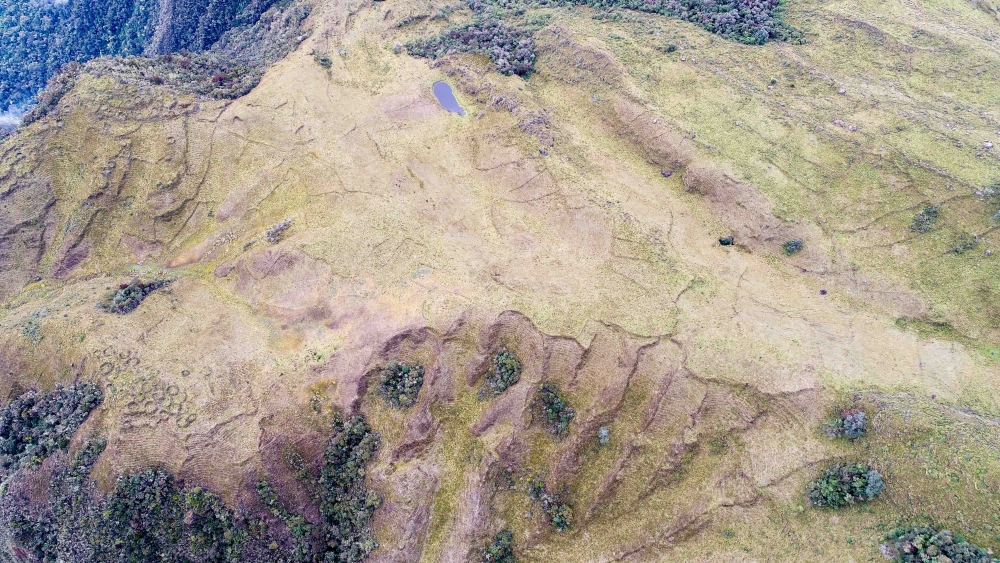Archaeologist and Assistant Professor of Anthropology Parker VanValkenburgh is examining this question through the lens of the Spanish colonial reducción movement of the 1570s—a large-scale attempt to "modernize" over two million indigenous Peruvians by resettling them into planned towns. Although many written records of this movement remain, they often omit key details about the founding of the towns or the effects of the resettlement effort on inhabitants' daily lives.

The ruins of the Iglesia Matriz (principal Church) of the Villa of Zaña, Peru, largely destroyed by an El Nino-linked flood in 1720. Photo: Parker VanValkenburgh
The ruins of the Iglesia Matriz (principal Church) of the Villa of Zaña, Peru, largely destroyed by an El Nino-linked flood in 1720. Photo: Parker VanValkenburgh
"The historical documents tend to offer high-level generalizations about the movement that don't reflect the complexities of this massive social engineering project," he says. "I am trying to use archaeology as a way to tell a more complicated story, or investigate the more complicated elements of this process."
To this end, VanValkenburgh and his colleagues have unearthed centuries-old settlements from the parched soil of Peru's coastal desert—both those that were home to indigenous groups prior to the Spanish invasion, and those that house the towns, or reducciones, constructed under colonial rule.
At the outset, some of his findings appear unsurprising. Within a few decades of the initial resettlement effort, Native people did appear to abandon the reducciones; but this subversion of colonial dictates appears to have been a move made out of necessity, rather than rebellion.
"The environment ended up being a really big part of the story, because the aridity of the Peruvian coast makes water access absolutely essential to life," he says. "Agricultural communities need irrigation water in order to be able to farm, and people need water in order to be able to live."
According to VanValkenburgh, colonial decimation of the indigenous population had likely made it impossible for Native people to maintain their existing canals and water infrastructure.
"When, all of a sudden, you have this massive collapse in population, all these new dynamics arise," he explains.
VanValkenburgh's findings suggest that Native communities simply moved upriver, to be closer to easy water access—an environmentally prescribed necessity that undermined Spanish administrators' attempts at permanent resettlement.
But rather than reverting to more traditional encampments after the move, these communities instead appeared to rebuild new settlements that were designed precisely to Spanish colonial specifications.
"Native people settle in towns that are almost excessively observant in their conformity to colonial norms," he says. "And they end up being able to renegotiate the terms of their other own subjugation."
And although, in this case, Native communities were able to get their needs met at the hands of their colonizers, the story doesn't end there. In fact, as VanValkenburgh explains, being socially marginalized in an unforgiving environment is a challenge that indigenous people have been living with since colonial times.
"The longer-term story here is that many of these same indigenous communities continue to live in these really marginal environments along the Peruvian coast," he says, recounting multiple storms in the 20th century that threatened or wiped out coastal Native towns. "People who are socially marginal are also environmentally marginal. The longer-term aspect of my research is: how does that happen? How is the environment, in a sense, ‘harnessed' in a way that marginalizes people?"

Abandoned terraces and associated archaeological sites at around 3600m elevation in the Chachapoyas region of Peru. Photo: Parker VanValkenburgh VanValkenburgh is continuing this work in a second project, which looks at a similar record of Native resettlement—but this time, on the Eastern slopes of the Andes, where the environment is extremely wet.
"I'm interested in the way in which this same story played out in a very different way, in a very different environment," he says. "The idea here is to keep the conditions the same, but to radically modify the environment as a variable and to see: do you see the same process where people are abandoning these towns and refounding them?"
In VanValkenburgh's view, archaeologists have a unique opportunity to discover and contemplate marginalized versions of history that offer lessons not only for humanity's present, but for our future as well. As he explains, people have always generated creative solutions to pressing issues—both in ways that we might expect and in ways that ultimately turned existing reality on its head.
"When you open up your mind to the entire expanse of human history—in all of its glory and all of its doom—I think it expands your imaginary toolkit for dealing with the big problems that we might face in the future," he concludes. "Thinking about the deep past, and examining the fact that there have been so many times in history when a small series of decisions radically changed the course of human societies is, I think, deeply inspiring."